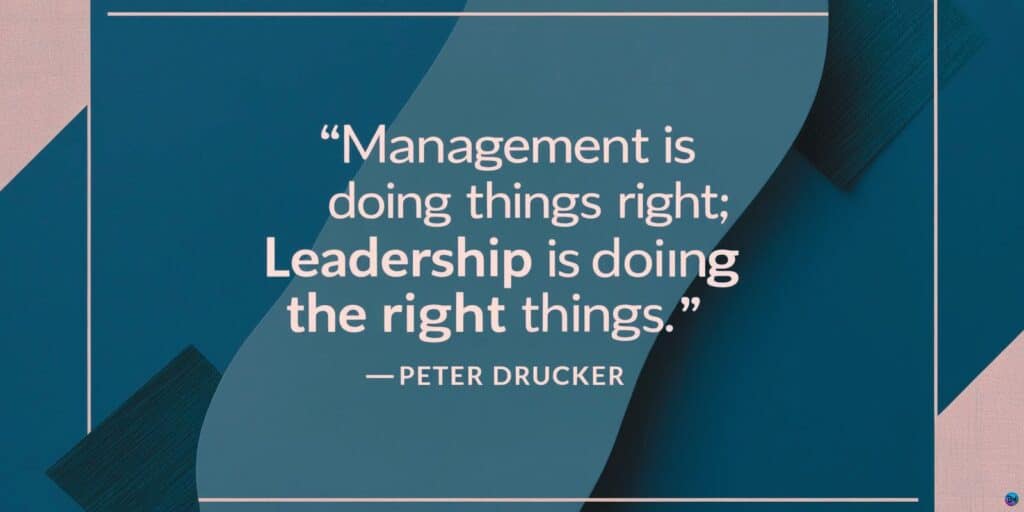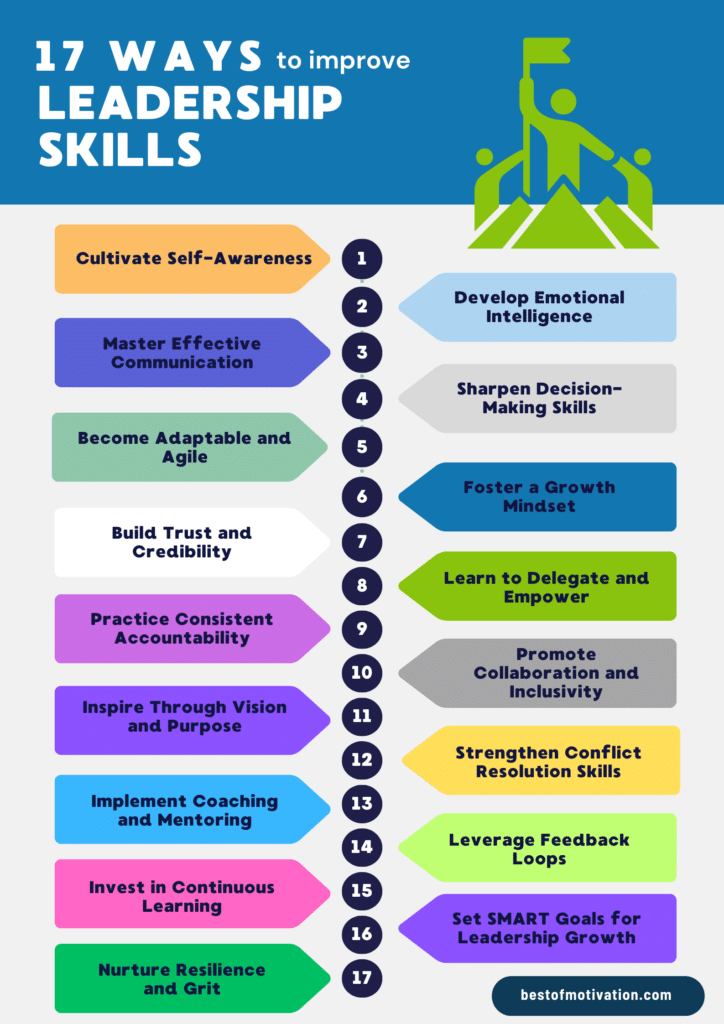📌 TL;DR — Leadership in 60 Seconds
Swipe through the core ideas of this leadership guide.
Self-awareness is the foundation of every great leader.
Manage your emotions — and read others — to build trust fast.
Clarity reduces conflict and boosts team confidence.
Use data + intuition. Action beats hesitation.
Flexible leaders thrive in change and uncertainty.
Skills grow with practice. Encourage learning daily.
Be consistent, fair, and always follow through.
Give ownership — don’t micromanage. Let people rise.
Own mistakes, track progress, and set clear expectations.
Diverse teams create better ideas and stronger results.
A clear mission energizes teams and boosts morale.
Handle issues directly and respectfully.
Grow people — and your influence grows too.
Regular feedback keeps teams aligned and improving.
Courses, books, and curiosity sharpen your edge.
Track your leadership progress with clear milestones.
Stay calm under pressure — your team mirrors your energy.
Most professionals eventually look for ways to improve their leadership skills so they can lead with more confidence, clarity, and impact. Learning how to improve leadership skills doesn’t require major changes — small, intentional habits can transform how your team sees you. Great leaders are built through consistency, self-awareness, and daily actions, not job titles.
In this article, we’ll explore how to develop leadership skills step by step, discuss why leadership is crucial in the modern workplace, and offer practical strategies to help you grow in leadership and make a positive impact on your team and organization.
In the sections below, we’ll walk you through foundational leadership principles, the difference between leadership and management, and specific, actionable ways to enhance your leadership capabilities. By the end, you’ll have a clear roadmap on how to strengthen leadership skills, how to improve leadership in the workplace, and how to continuously evolve as a leader.

📱 Listen to Our Latest Leadership Podcast
Want to elevate your leadership skills? Our new episode explores the shift from traditional management to inspirational leadership.
Listen Now: Transformational Leadership – From Command to Inspiration
Understanding the Core of Effective Leadership
Leadership is the ability to guide, motivate, and influence others toward the accomplishment of goals. It’s not confined to those with “manager” or “director” titles—leaders can emerge at every level of an organization. True leadership integrates a combination of self-awareness, emotional intelligence, communication skills, and strategic thinking, among other traits.
Key Insight: Leadership is about creating a vision and inspiring others to pursue that vision. It’s a relational concept, existing in the dynamic between leaders and their teams.
Historically, leadership was often viewed as an innate quality—something you’re born with rather than learn. Modern research, however, suggests that leadership competencies can be cultivated through deliberate practice, self-reflection, and a willingness to learn from mistakes. In other words, you can absolutely grow your leadership skills with the right mindset and strategic effort.
Want to lead with more self-awareness? Discover your personality color and see how it shapes your leadership style.

These principles are essential for anyone learning how to improve leadership skills in a real-world workplace
📘 Research Insight
According to the Center for Creative Leadership, the strongest leaders consistently master four core skills: self-awareness, communication, influence, and learning agility. These behaviours form the foundation of effective leadership at every stage of a career.
Source: Center for Creative Leadership — 4 Core Leadership Skills for Every Career Stage
Why Improving Leadership Skills Matters in Today’s Workplace
In a rapidly evolving world, leaders are expected to navigate uncertainty, drive innovation, and foster inclusive cultures. According to a recent study by Harvard Business Review, companies led by effective leaders are significantly more likely to outperform their competitors in key performance metrics like profitability, employee engagement, and innovation. Additionally, Statista reports that over 80% of organizations view leadership development as a crucial issue, investing billions annually to train and mold better leaders.
Why does this matter to you? Strong leadership skills elevate your career prospects, improve team morale, and lead to better outcomes for your organization. If you’re aiming to stand out in your field, there’s no better time to learn how to improve leadership abilities than right now.
Leadership vs. Management
Many people conflate leadership with management. Although there’s overlap, the two concepts aren’t identical:
- Leadership is about charting a course, inspiring others, and cultivating a supportive environment where people can do their best work.
- Management focuses on overseeing processes, coordinating tasks, and maintaining efficiency.

“Management is doing things right; leadership is doing the right things.” — Peter Drucker
To be truly effective, you often need a balance of both. However, prioritizing leadership fosters an environment of innovation and respect, whereas focusing solely on management can sometimes lead to a narrow emphasis on productivity without the human-centric touch.
Leading a team through challenging periods?
Read: How to Support Your Team During Busy Seasons →17 Actionable Leadership Skills You Can Start Improving Today
Below are 17 proven strategies and practical methods to further develop leadership factors that will boost not just your performance, but also your team’s collective success. Integrate these suggestions into your daily routine, and you’ll see a measurable improvement in how you grow as a leader.

1. Cultivate Self-Awareness
Why It’s Important: Great leadership begins with self-awareness. Understanding your strengths, weaknesses, and behavioral patterns sets the stage for authentic leadership.
How to Do It:
- Reflect Regularly: Spend 10 minutes each day journaling about key interactions. Ask yourself what went well, what didn’t, and how you can improve.
- Seek Feedback: Request input from peers, mentors, or even direct reports. Tools like 360° assessments can be illuminating.
- Personal SWOT Analysis: List out your Strengths, Weaknesses, Opportunities, and Threats. This exercise clarifies areas of focus for growth.
By actively working on your self-awareness, you’ll develop a leadership style that’s genuine, transparent, and built on continuous self-improvement.
2. Develop Emotional Intelligence
Why It’s Important: Emotional intelligence (EQ) is the ability to understand and manage your emotions and those of others. A high EQ leads to better team relationships, conflict resolution, and communication.
How to Do It:
- Practice Empathy: Strive to see situations from other people’s perspectives. Ask open-ended questions, and truly listen to responses.
- Monitor Your Triggers: Identify situations or comments that provoke strong emotional reactions. Recognizing triggers helps you manage them more effectively.
- Improve Active Listening: Maintain eye contact, use paraphrasing to confirm understanding, and resist the urge to interrupt.
Leadership Fact: According to a study by TalentSmart, 90% of top performers possess high emotional intelligence, indicating EQ’s direct link to professional success.
Great leadership begins with understanding how you think.
Discover Your AI Superpower →3. Master Effective Communication
Why It’s Important: Communication is the backbone of leadership. The ability to articulate a vision, give clear direction, and provide constructive feedback can make or break team performance.
How to Do It:
- Be Concise and Clear: Whether you’re leading a meeting or sending an email, clarity eliminates confusion and builds trust.
- Use the Right Medium: Match your communication style to the message. Sensitive conversations are best held face-to-face or via video calls rather than emails.
- Provide Constructive Feedback: Frame your feedback in a way that focuses on growth rather than blame. Use the “sandwich technique”: compliment, critique, compliment.
Leaders who communicate effectively encourage a culture of openness and transparency, which in turn fosters trust and accountability within teams.
Want to build stronger relationships with your colleagues?
Read: Communication in the Workplace – Build Stronger Connections →4. Sharpen Decision-Making Skills
Why It’s Important: Leaders face critical decisions daily, from hiring choices to strategic planning. Effective decision-making balances data, intuition, and the potential risks of each option.
How to Do It:
- Gather Data: Look for credible sources, such as market research or analytics, to inform your options.
- Weigh Risks and Benefits: Consider short-term gains versus long-term implications.
- Make Timely Decisions: Procrastination can stall your team’s progress. Don’t wait for absolute certainty—make the best choice with the information you have.
By making well-informed, timely decisions, you demonstrate confidence and clarity, inspiring your team to follow your lead.
5. Become Adaptable and Agile
Why It’s Important: Today’s business landscape changes rapidly. Leaders who remain flexible can pivot strategies effectively, thus maintaining competitiveness and relevance.
How to Do It:
- Embrace Change: Adopt a growth mindset that views challenges as opportunities for innovation.
- Encourage Experimentation: Give your team the freedom to test new ideas. Celebrate lessons from failures.
- Stay Current: Continuously update your knowledge of industry trends, emerging technologies, and evolving consumer behaviors.
Adaptable leaders set the tone for an agile workplace, where teams feel empowered to innovate and respond to new challenges head-on.
6. Foster a Growth Mindset
Why It’s Important: A growth mindset, a term popularized by psychologist Carol Dweck, is the belief that abilities can be developed through dedication and hard work. Leaders who embody this inspire their teams to learn and evolve.
How to Do It:
- Celebrate Progress: Recognize small wins and improvements, not just the final result.
- Normalize Mistakes: Treat failures as part of the learning journey. Use them as teachable moments rather than reasons for reprimand.
- Set Learning Goals: Aim to learn a new skill each quarter, whether it’s a software tool or a leadership competency.
A growth mindset fosters resilience, creativity, and a culture of continuous learning—all traits of high-performing teams.
7. Build Trust and Credibility
Why It’s Important: Trust is the glue that holds teams together. Without it, employees may feel disengaged, skeptical, or even fearful about their roles.
How to Do It:
- Be Transparent: Share relevant information openly. Honesty about challenges and successes builds credibility.
- Follow Through: Honor your commitments. If you promise to resolve an issue or provide resources, do so promptly.
- Practice Fairness: Treat everyone with respect, regardless of their position or background.
Stat: A 2019 survey by Forbes revealed that employees in high-trust organizations report 74% less stress, 50% higher productivity, and 29% more satisfaction with their lives.
8. Learn to Delegate and Empower
Why It’s Important: Delegation is more than offloading tasks—it’s about empowering team members to grow their skills and take ownership. Effective delegation frees you to focus on strategic priorities while nurturing the development of your direct reports.
How to Do It:
- Identify Strengths: Match tasks to individuals who have the right skill sets or show promise in that area.
- Set Clear Expectations: Provide clear objectives, timelines, and resources for success.
- Provide Support, Not Micromanagement: Check in periodically, but allow autonomy in how tasks are completed.
When you delegate effectively, you help create a culture of ownership and accountability, fueling both individual and organizational growth.
9. Practice Consistent Accountability
Why It’s Important: Accountability is a leadership cornerstone that ensures everyone upholds their responsibilities, including you. It sets a standard of excellence and trustworthiness.
How to Do It:
- Establish Clear KPIs: Define Key Performance Indicators for your team and yourself. Everyone should understand the metrics of success.
- Own Your Mistakes: If you make a wrong call, be transparent. Show how you plan to rectify it.
- Regular Check-Ins: Schedule consistent one-on-ones or team huddles to review progress and provide support.
This blend of personal responsibility and team oversight fosters a high-performing environment where people feel motivated and secure.
10. Promote Collaboration and Inclusivity
Why It’s Important: Leaders who cultivate an inclusive and collaborative culture see stronger team bonds, heightened creativity, and improved problem-solving. Diversity of thought fosters innovation.
How to Do It:
- Use Inclusive Language: Mind your words to make sure everyone feels welcome and valued.
- Encourage Cross-Functional Teams: Mix people from different departments or skill sets for broader perspectives.
- Offer Equal Opportunities: Provide equitable access to resources, training, and leadership pathways.
An inclusive environment nurtures respect, creativity, and unity, which can significantly enhance leadership in the workplace.
11. Inspire Through Vision and Purpose
Why It’s Important: A compelling vision acts like a lighthouse, guiding the organization through good times and bad. Leaders who effectively communicate and embody this vision can rally teams toward a common goal.

How to Do It:
- Craft a Clear Mission Statement: Align it with your team’s goals and values.
- Link Daily Tasks to the Bigger Picture: Show how individual responsibilities feed into the organization’s overarching mission.
- Be Enthusiastic: Passion is contagious. If you’re excited about the mission, your team will be too.
Leaders who anchor their approach in a shared vision provide motivation that transcends paychecks, sparking genuine dedication and creativity among employees.
Want to discover the key leadership traits shaping 2025–2026?
Read: Top Leadership Traits for 2025–2026 →12. Strengthen Conflict Resolution Skills
Why It’s Important: Conflicts are inevitable in any team. A leader who manages them effectively prevents issues from escalating and preserves a positive work climate.
How to Do It:
- Address Issues Early: Don’t let tensions simmer until they boil over.
- Active Listening: Understand all perspectives before proposing a solution.
- Focus on Solutions, Not Blame: Guide the conversation toward resolving the issue rather than assigning fault.
Conflict resolution done well leads to stronger relationships, deeper mutual respect, and a cohesive team environment.
13. Implement Coaching and Mentoring
Why It’s Important: Great leaders serve as coaches and mentors, providing guidance that helps others unlock their potential. This isn’t about micromanagement but about strategic support.
How to Do It:
- Set Regular Mentorship Sessions: Discuss goals, challenges, and progress. Offer actionable advice.
- Encourage Peer Coaching: Pair team members who have complementary skills to learn from each other.
- Provide Resources: Share articles, books, and training courses that can accelerate development.
By coaching and mentoring, you strengthen not just individual team members but also your entire organizational culture.
14. Leverage Feedback Loops
Why It’s Important: Feedback loops create a continuous cycle of improvement, fostering openness and growth in teams. Leaders who actively seek and provide feedback cultivate a transparent and dynamic environment.
How to Do It:
- Establish Regular Reviews: Whether weekly or monthly, use structured sessions to exchange feedback.
- Encourage Peer Feedback: Build a team culture where individuals feel comfortable sharing insights.
- Act on Feedback: Show you value input by implementing viable suggestions and recognizing contributors.
Creating a feedback-rich atmosphere helps everyone (including you) improve, innovate, and stay aligned with the organization’s goals.
15. Invest in Continuous Learning
Why It’s Important: The most effective leaders never stop learning. Whether it’s reading books on leadership, taking online courses, or attending seminars, ongoing education keeps your skills sharp and relevant.
How to Do It:
- Create a Learning Plan: Identify one major leadership competency you want to develop each quarter.
- Explore Online Platforms: Websites like Coursera and LinkedIn Learning offer courses on leadership, communication, and strategy.
- Attend Workshops and Webinars: Look for industry-specific events or online webinars hosted by reputable institutions.
Leaders who continuously expand their knowledge are better equipped to innovate and adapt, making them indispensable in any organization.
16. Set SMART Goals for Leadership Growth
Why It’s Important: SMART (Specific, Measurable, Achievable, Relevant, Time-bound) goals provide clarity and trackable progress. Setting leadership-focused SMART goals helps you measure how effectively you’re growing.
How to Do It:
- Be Specific: Instead of “improve communication,” aim for “deliver weekly team updates with clarity and brevity.”
- Track Progress: Use metrics like survey feedback or completion rates of delegated tasks.
- Review and Adjust: Revisit your goals monthly. If you’re not progressing, refine them or adjust your strategies.
SMART goals serve as a roadmap, steering you toward tangible leadership improvements rather than vague aspirations.
Ready to Transform Your Goals into Reality? ✨
Join thousands of achievers who’ve already created their success roadmap
Free tool • Takes only 3 minutes
17. Nurture Resilience and Grit
Why It’s Important: Leadership can be emotionally taxing. Resilience and grit enable you to bounce back from setbacks, maintain a positive attitude, and continue leading effectively even under pressure.
How to Do It:
- Practice Mindfulness: Techniques like meditation or mindful breathing reduce stress and improve emotional regulation.
- Take Breaks: Recharge to avoid burnout. A simple walk or short exercise routine can do wonders for your mental clarity.
- Focus on the Big Picture: Remind yourself why you’re a leader—your mission, your team, and the change you want to create.
Leaders with resilience and grit consistently model perseverance, inspiring their teams to do the same.
Want to understand how burnout impacts team morale and leadership?
Read: Retail Worker Burnout — Energy Reset Strategies →
Real-World Examples of Leadership Evolution
- Oprah Winfrey (Media Mogul): Known for her authentic and empathetic leadership, Oprah built a media empire that emphasizes personal growth and empowerment. She delegates to experts in various areas while maintaining accountability, resulting in high-quality content that resonates globally.
- Sheryl Sandberg (COO of Meta/Facebook): Sandberg’s leadership at Facebook showcases her strength in communication and vision. Her book Lean In illustrates how fostering inclusivity and actively supporting women in leadership roles can elevate the entire organization.
These examples highlight leaders who actively embody the principles we’ve discussed—emotional intelligence, vision, resilience, and continuous learning. They serve as living proof that leadership is a craft honed over time, not an inherent trait bestowed at birth.
Practical Exercises to Boost Leadership Abilities
- Daily Leadership Journal
- Time Requirement: 5–10 minutes
- Process: Write down a scenario that tested your leadership. Reflect on what went well, what could improve, and any feedback received.
- Benefit: Reinforces self-awareness and continuous improvement.
- Role-Swapping Workshops
- Time Requirement: 1-hour weekly session
- Process: Rotate tasks among team members or simulate each other’s roles.
- Benefit: Builds empathy, collaboration, and a holistic understanding of different functions.
- Feedback Roundtables
- Time Requirement: 30 minutes–1 hour biweekly
- Process: Allocate time for everyone to give one piece of positive feedback and one piece of constructive feedback to any teammate.
- Benefit: Promotes open communication, reduces tension, and normalizes feedback culture.
- Conflict Resolution Simulations
- Time Requirement: 30 minutes–1 hour monthly
- Process: Present a hypothetical conflict scenario. Have small groups brainstorm solutions and then discuss as a larger team.
- Benefit: Sharpens problem-solving, active listening, and negotiation skills—core to leadership in the workplace.
❓ Frequently Asked Questions About How to Improve Leadership Skills
1. How long does it take to improve leadership skills?
Some aspects of leadership — like communication or confidence — can improve within a few weeks, while deeper abilities such as emotional intelligence take time and consistent practice. The key to how to improve leadership skills long-term is consistency and self-reflection.
2. Do I need a management role to learn how to improve leadership skills?
No — you can develop leadership skills at any level. Taking initiative, mentoring others, supporting teammates, and leading small projects are all effective ways to improve leadership skills without a formal title.
3. How do I overcome imposter syndrome while growing as a leader?
Imposter syndrome is common, even among experienced leaders. Track your wins, seek feedback, and remind yourself that leadership is practiced, not inherited. These are all essential parts of how to improve leadership skills with confidence.
4. Can introverts improve their leadership skills?
Yes — introverts often excel in deep thinking, empathy, and active listening. These strengths make introverts very effective when focusing on how to improve leadership skills through their natural style.
5. What can I do if my company offers no leadership training?
Leadership growth doesn’t depend on formal programs. Online courses, books, podcasts, and peer-learning groups all help you improve leadership skills on your own schedule.
Conclusion and Next Steps
Leadership is not a static trait but a dynamic, evolving set of abilities that require continuous learning, practice, and self-reflection. By focusing on how to grow in leadership, you not only elevate your own career but also empower those around you to perform at their best. From self-awareness and communication to accountability and agility, each facet of leadership can be refined over time.
By applying these ideas consistently, you’ll see steady progress in how to improve leadership skills over time
Call to Action: Start your leadership journey today by picking two or three strategies from this guide—like cultivating self-awareness, developing a growth mindset, or practicing consistent accountability—and commit to mastering them over the next month. Track your progress, adjust as needed, and watch your leadership abilities increase and flourish.
⭐ Key Takeaways
The most important leadership lessons from this guide.
Understanding your strengths, weaknesses, and triggers is the foundation of effective leadership.
Clear, concise, and empathetic communication builds trust and alignment.
Managing emotions—your own and others’—creates a healthier, more productive culture.
Use data, intuition, and timely action to guide your team forward.
Agile leaders pivot quickly and help teams navigate uncertainty.
See challenges as opportunities and encourage ongoing learning.
Transparency, fairness, and follow-through strengthen relationships.
Sharing responsibility helps others grow while freeing you for strategic work.
Owning results—good or bad—sets a powerful example for your team.
Clearly connecting daily tasks to a bigger mission motivates people to excel.
Staying calm under pressure boosts team confidence and stability.
📥 Download Your Free Weekly Leadership Planner
Transform your leadership journey with our structured planning template. Click here to get instant access to your weekly leadership guide.
References and Further Reading
- Harvard Business Review – For research-based articles on leadership, management, and organizational behavior.
- Forbes – Offers articles and statistics on workplace productivity, trust, and leadership trends.
- Statista – Provides up-to-date data on leadership training budgets and employee engagement metrics.
- Mindset by Carol S. Dweck – Seminal book on cultivating a growth mindset for personal and professional development.
Internal Links
- If you’re looking to boost personal productivity alongside your leadership skills, check out our post on Mastering Time Management for Career Growth (Example link).
- For more on fostering a positive, growth-oriented mindset, read our article on How to Stay Motivated and Achieve Your Goals
Transform Your Busy Season with the 5R Leadership Toolkit
Lead stronger, reduce overwhelm, and bring clarity to your team. Get the complete Excel, PDF & Notion toolkit — built to help modern leaders simplify decisions and stay in control.
Get the 5R Leadership Toolkit →Instant download • Editable formats • Proven in real retail leadership











From start to finish, this blog post had us hooked. The content was insightful, entertaining, and had us feeling grateful for all the amazing resources out there. Keep up the great work!
Thank you